
| Mechanical failure modes |
|---|
Hydrogen embrittlement (HE), also known as hydrogen-assisted cracking or hydrogen-induced cracking (HIC), is a reduction in the ductility of a metal due to absorbed hydrogen. Hydrogen atoms are small and can permeate solid metals. Once absorbed, hydrogen lowers the stress required for cracks in the metal to initiate and propagate, resulting in embrittlement. Hydrogen embrittlement occurs in steels, as well as in iron, nickel, titanium, cobalt, and their alloys. Copper, aluminium, and stainless steels are less susceptible to hydrogen embrittlement.[1][2][3][4]
The essential facts about the nature of hydrogen embrittlement have been known since the 19th century.[5][6] Hydrogen embrittlement is maximised at around room temperature in steels, and most metals are relatively immune to hydrogen embrittlement at temperatures above 150 °C.[7] Hydrogen embrittlement requires the presence of both atomic ("diffusible") hydrogen and a mechanical stress to induce crack growth, although that stress may be applied or residual.[2][8][9] Hydrogen embrittlement increases at lower strain rates.[1][2][10] In general, higher-strength steels are more susceptible to hydrogen embrittlement than mid-strength steels.[11]
Metals can be exposed to hydrogen from two types of sources: gaseous hydrogen and hydrogen chemically generated at the metal surface. Gaseous hydrogen is molecular hydrogen and does not cause embrittlement though it can cause hot hydrogen attack (see below). It is the atomic hydrogen from chemical attack which causes embrittlement because the atomic hydrogen dissolves quickly into the metal at room temperature.[6] Gaseous hydrogen is found in pressure vessels and pipelines. Electrochemical sources of hydrogen include acids (as may be encountered during pickling, etching, or cleaning), corrosion (typically due to aqueous corrosion or cathodic protection), and electroplating.[1][2] Hydrogen can be introduced into the metal during manufacturing by the presence of moisture during welding or while the metal is molten. The most common causes of failure in practice are poorly-controlled electroplating or damp welding rods.
Hydrogen embrittlement as a term can be used to refer specifically to the embrittlement that occurs in steels and similar metals at relatively low hydrogen concentrations, or it can be used to encompass all embrittling effects that hydrogen has on metals. These broader embrittling effects include hydride formation, which occurs in titanium and vanadium but not in steels, and hydrogen-induced blistering, which only occurs at high hydrogen concentrations and does not require the presence of stress.[10] However, hydrogen embrittlement is almost always distinguished from high temperature hydrogen attack (HTHA), which occurs in steels at temperatures above 204 °C and involves the formation of methane pockets.[12] The mechanisms (there are many) by which hydrogen causes embrittlement in steels are not comprehensively understood and continue to be explored and studied.[1][13][14]
- ^ a b c d Lynch, S. P. (2011-01-01), Raja, V. S.; Shoji, Tetsuo (eds.), "2 - Hydrogen embrittlement (HE) phenomena and mechanisms", Stress Corrosion Cracking, Woodhead Publishing Series in Metals and Surface Engineering, Woodhead Publishing, pp. 90–130, ISBN 978-1-84569-673-3, retrieved 2022-06-10
- ^ a b c d Cite error: The named reference
nasawas invoked but never defined (see the help page). - ^ Jewett, R. P.; Walter, R. J.; Chandler, W. T.; Frohmberg, R. P. (1973-03-01). "Hydrogen environment embrittlement of metals". NTRS. NASA. Archived from the original on May 25, 2024.
- ^ Safety Standard for Hydrogen and Hydrogen Systems: Guidelines for Hydrogen System Design, Materials Selection, Operations, Storage, and Transportation (PDF). Washington, DC: Office of Safety and Mission Assurance, National Aeronautics and Space Administration. 1997-10-29. p. A-93. NSS 1740.16. Retrieved 2022-06-27.
- ^ Johnson, William H. (31 December 1875). "II. On some remarkable changes produced in iron and steel by the action of hydrogen and acids". Proceedings of the Royal Society of London. 23 (156–163): 168–179. doi:10.1098/rspl.1874.0024. eISSN 2053-9126. ISSN 0370-1662. JSTOR 113285. S2CID 97579399.
- ^ a b Cite error: The named reference
HarryBwas invoked but never defined (see the help page). - ^ "What is hydrogen embrittlement? – Causes, effects and prevention". TWI - The Welding Institute. Retrieved 18 December 2020.
- ^ Oriani, R A (August 1978). "Hydrogen Embrittlement of Steels". Annual Review of Materials Science. 8 (1): 327–357. Bibcode:1978AnRMS...8..327O. doi:10.1146/annurev.ms.08.080178.001551. ISSN 0084-6600.
- ^ "Hydrogen Embrittlement". Metallurgy for Dummies. Retrieved 18 December 2020.
- ^ a b Louthan, M. R. (2008-06-01). "Hydrogen Embrittlement of Metals: A Primer for the Failure Analyst". Journal of Failure Analysis and Prevention. 8 (3): 289–307. doi:10.1007/s11668-008-9133-x. ISSN 1864-1245. S2CID 51738408.
- ^ Li, Hanyu; Niu, Ranming; Li, Wei; Lu, Hongzhou; Cairney, Julie; Chen, Yi-Sheng (September 2022). "Hydrogen in pipeline steels: Recent advances in characterization and embrittlement mitigation". Journal of Natural Gas Science and Engineering. 105: 104709. Bibcode:2022JNGSE.10504709L. doi:10.1016/j.jngse.2022.104709. S2CID 250713252.
- ^ TWI – The Welding Institute. "What is high temperature hydrogen attack (HTHA) / hot hydrogen attack?". TWI - The Welding Institute. Retrieved 16 December 2020.
- ^ Barnoush, Afrooz. "Hydrogen embrittlement revisited by in situ electrochemical nanoindentations" (PDF). Archived from the original (PDF) on 2011-05-18. Retrieved 18 December 2020.
- ^ Cite error: The named reference
robertson15was invoked but never defined (see the help page).